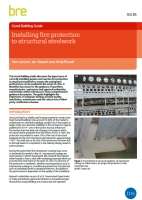Installing fire protection to structural steelwork (GG 85)
Steel-framed buildings now (2017) account for 66% of the market in multi-storey non-domestic buildings and 88.5% of the market in single-storey non-domestic buildings in the UK. In 1981, fire protection accounted for 31% of the cost of structural steelwork, but by 2007, this was just 17%.
During this period, thin-film intumescent coatings came to dominate the market. These are water-based or solvent based paint like materials that expand when heated to form a ‘char’ which protects steel in the event of fire. The performance of this, and other forms of protection, such as insulating boards or sprayed protection, is dependent on the quality of the installation.
BRE (Building Research Establishment) is an independent, research-based consultancy, testing and training organisation, operating in the built environment and associated industries. On 3 May 2017, BRE published, Installing fire protection to structural steelwork (GG 85) written by Tom Lennon, Ian Stewart and Andy Russell.
The 8 page Good Building Guide addresses the importance of correctly installing passive and reactive fire protection to structural steelwork to ensure expected performance criteria are achieved in the event of a fire. It identifies key issues for specifiers, manufacturers, contractors and approval authorities and includes references to more comprehensive sources of information.
The guide highlights the importance of adequate testing, quality, installation and maintenance as well as the critical role played by third-party certification schemes.
Its contents includes:
- Introduction.
- Structural steel in fire.
- Regulatory requirements.
- Forms of passive and reactive fire protection to structural steelwork.
- Installation.
- Test, assessment and certification requirements.
- Third-party certification.
- Fire risk assessment.
- Liaison between all parties.
- Checklist.
- Summary.
- References.
[edit] Find out more
[edit] Related articles on Designing Buildings Wiki
- Approved document B.
- BS 9999.
- Concrete vs. steel.
- Fire and rescue service.
- Fire authority.
- Fire detection and alarm system.
- Fire prevention on construction sites.
- Fire protection engineering.
- Fire safety design.
- Guidance for construction quality management professionals: Structural Steelwork.
- Intumescent coatings.
- Metal fabrication.
- Passive and reactive fire protection to structural steel (IP 6 12).
- Steel construction floor vibration
- Steel reinforcement
- Steel.
- Steel-concrete composite structures
- Structural steel
- The causes of false fire alarms in buildings.
- The Regulatory Reform (Fire Safety) Order 2005.
- The role of codes, standards and approvals in delivering fire safety.
Featured articles and news
RTPI leader to become new CIOB Chief Executive Officer
Dr Victoria Hills MRTPI, FICE to take over after Caroline Gumble’s departure.
Social and affordable housing, a long term plan for delivery
The “Delivering a Decade of Renewal for Social and Affordable Housing” strategy sets out future path.
A change to adoptive architecture
Effects of global weather warming on architectural detailing, material choice and human interaction.
The proposed publicly owned and backed subsidiary of Homes England, to facilitate new homes.
How big is the problem and what can we do to mitigate the effects?
Overheating guidance and tools for building designers
A number of cool guides to help with the heat.
The UK's Modern Industrial Strategy: A 10 year plan
Previous consultation criticism, current key elements and general support with some persisting reservations.
Building Safety Regulator reforms
New roles, new staff and a new fast track service pave the way for a single construction regulator.
Architectural Technologist CPDs and Communications
CIAT CPD… and how you can do it!
Cooling centres and cool spaces
Managing extreme heat in cities by directing the public to places for heat stress relief and water sources.
Winter gardens: A brief history and warm variations
Extending the season with glass in different forms and terms.
Restoring Great Yarmouth's Winter Gardens
Transforming one of the least sustainable constructions imaginable.
Construction Skills Mission Board launch sector drive
Newly formed government and industry collaboration set strategy for recruiting an additional 100,000 construction workers a year.
New Architects Code comes into effect in September 2025
ARB Architects Code of Conduct and Practice available with ongoing consultation regarding guidance.
Welsh Skills Body (Medr) launches ambitious plan
The new skills body brings together funding and regulation of tertiary education and research for the devolved nation.
Paul Gandy FCIOB announced as next CIOB President
Former Tilbury Douglas CEO takes helm.
UK Infrastructure: A 10 Year Strategy. In brief with reactions
With the National Infrastructure and Service Transformation Authority (NISTA).
























